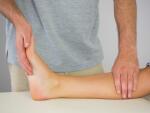What is a torn meniscus?
Your knee has many working parts that allow you to move it efficiently and support you as you stand. One of these vital parts is the meniscus. It acts like a cushion, or shock absorber between your tibia (shinbone) and femur (thigh bone) and helps you balance your weight on your knee. You have two menisci in each knee, on the inner side of your knee (medial meniscus) and the outer side of your knee (lateral meniscus). These C-shaped pieces of cartilage can tear, particularly as you get older and the meniscus becomes worn.
A meniscus tear is a common knee injury, not only among athletes but for just about anyone. There can be a traumatic meniscal tear, caused by trauma or accident, or a degenerative meniscus tear, which occurs from wear and tear on the knee. Orthopedic surgeons classify the tears according to their severity, which meniscus is involved, and how complex the tear is.
If you have a torn meniscus and your knee feels like it has locked, either in a bent position or straight, you should seek medical help as quickly as possible. If your knee is not locked, but you feel pain and suspect you may have a meniscus tear or other knee injury, see your doctor. Left untreated, you could experience long-term instability in your knee if the meniscus injury is not treated properly.
What are the symptoms of a torn meniscus?
Common torn meniscus symptoms are knee pain and swelling. Knee pain with a torn meniscus worsens when you move your knee or put weight on it. If you have a medial meniscus tear, you may also have swelling on the inside of your knee. If you have a lateral meniscus tear, the swelling will be on the outer part of your knee. Knee swelling may not appear right after the injury, particularly if it is a degenerative meniscus tear, and can take hours or days to become apparent. You may also find it hard to squat or cross your legs. Some people report feeling as if their knee is popping or clicking, perhaps about to ‘give way.’
A locked knee could mean that a piece of the meniscus has broken free and has moved into the knee joint.
If you experience symptoms of a meniscus tear, particularly if you’ve twisted or injured your knee in some way, check with your doctor for a full evaluation. Your doctor may perform a meniscus tear test called the McMurray test. This is done by bending your knee and then straightening and rotating it. If you have a torn meniscus, there will be an audible clicking sound. Knee MRI (magnetic resonance imaging) is a noninvasive method of diagnosing a torn meniscus.
Waiting may worsen the injury, making it more difficult to fully heal. Seek prompt medical attention so treatment can start as soon as possible if you have a torn meniscus.
What causes a torn meniscus?
Any activity that causes your knee to twist or turn can cause a meniscal tear. For example, this often happens to athletes who suddenly stop and pivot or twist while their foot remains planted on the ground. Other activities that could cause a tear include:
Kneeling
Squatting, particularly deep squats
Lifting something heavy with your knees bent
If the meniscus has degenerated and is worn and fragile, there may be no one particular action or movement that results in the meniscal tear.
The pain and swelling may go away on their own after a few weeks; however, meniscus tear symptoms often return if you resume activities that put pressure or strain on your knee. See your primary care doctor or an orthopedic specialist for an accurate diagnosis and care recommendations.
What are the risk factors for a torn meniscus?
Anyone who participates in a vigorous sport or activity, particularly soccer or rugby is at risk of a torn meniscus. People at highest risk of degenerative torn meniscus tears are:
Men (more men than women tear menisci)
People who perform work-related kneeling and squatting
People who climb multiple flights of stairs regularly
People who waited for more than year for an ACL injury repair
Reducing your risk of a torn meniscus
You may be able to lower your risk of a torn meniscus by:
Warming up and stretching before activities that put strain on your knee
Strengthening the muscles around your knees
Practicing pivoting in safe manner
Walking carefully on slippery surfaces, such as icy sidewalks or wet floors
Having ACL surgery in a timely manner if you have or had a torn ACL
Many people experience knee pain and it can become even more common as you age. If you have knee pain, particularly associated with swelling or a feeling of instability, see your doctor for a full knee assessment. In many cases, physical therapy and activity modifications can aid the healing process, provide pain relief, and prevent more serious knee injury.
How is a torn meniscus treated?
Torn meniscus treatment and recovery varies among patients by the type of tear, how it occurred, and the patient’s age and overall health. Small tears or tears on the outside of the meniscus may not require surgical repair. In this case, your doctor may recommend the RICE treatment, along with over-the-counter anti-inflammatory medicines like ibuprofen.
These RICE steps help the healing process:
Rest: Do not bear weight on your knee.
Ice: Apply ice packs to your knee for 20 minutes at a time, at least every two hours.
Compression: Apply a compression bandage around your knee without affecting blood circulation to the rest of your leg. Ask your doctor or nurse about the right amount of compression if you are not sure.
Elevation: Elevate your leg.
You may need to use a walking aid—like crutches—to keep weight off your knee as it heals.
For more severe meniscus tears and symptoms that do not resolve with RICE, surgery may be necessary. Meniscus surgery is usually an arthroscopic procedure, where an orthopedic surgeon makes a few tiny incisions in your knee. The surgeon inserts a small surgical camera (arthroscope) through one incision and makes the repairs with special instruments inserted through the other incisions. The camera transmits an image to a monitor in the operating room, which allows the surgeon to see the inside of your knee. Most of the time the surgeon either stitches the meniscus back together or removes the damaged part of the meniscus. The goal of surgery is to save the meniscus.
You may need to wear a cast or brace for a few weeks after surgery to keep your knee immobile. After initial healing, physical therapy and rehabilitation will help restore your knee’s strength and mobility. Recovery time for torn meniscus repair surgery is approximately three months.
What are the potential complications of a torn meniscus?
Your knee may produce extra joint fluid when you have a torn meniscus, which causes swelling. This swelling may make it difficult for you to move your knee and you may be tempted to keep it in a bent position for comfort. This, in turn, can put stress on your hamstring causing stiffness in your leg. Not treating a torn meniscus could result in constant knee pain and instability. Eventually, you could have a higher risk of developing osteoarthritis in the affected knee. To reduce your risk of complications, see an orthopedic specialist for a careful examination and to learn about treatment options for a torn meniscus.




